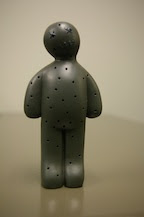
My eyes always glaze over when anyone in the Smokies discusses the timeshare industry. This is generally due to two overwhelming perspectives about timeshare: First, it appears to be an overly complicated way of booking a hotel room. Second, it is an industry plagued by negative images, take for example an episode of South Park where unwitting families sit through an endless timeshare presentation ("Asspen," 2002). But timeshare can teach us a lot about the role of sight in the tourism industry, particularly when the tables are turned and those who are usually doing the sightseeing [tourists] become the sight. All I can say is Dean MacCannell and Erving Goffman, hold onto your horses!
The essence of tourism is hypervisuality and no one understand this more than the OPCs or "Off-Project Consultants" who pitch timeshare to tourists. One of the best in the business is my friend Stan, who spends between three and eight hours a day inside a small booth where he is constantly watching tourists. Depending on where he is stationed, the booth's décor might be rustic, with rough, unpolished wooden surfaces and a sign on top that proclaims "Hiking Service" or the booth might be more modern looking with smoother lines and pastel colored walls interrupted by offers for discounts to amusement parks. All of the OPC booths are recessed within a small slot, usually wedged between stores. There are only three walls defining the back and sides of each booth so that the front is completely open to the sidewalk. Stan is always exposed to the elements so that inside the booth there is a constant din of either box fans or space heaters. Glossy brochures for tourist attractions and coupon books proclaiming to save the user hundreds of dollars act as bait for unwitting consumers.
From this booth, Stan has a perfect vantage point of the tourists who walk by, allowing him to assess their social, political, and economic assets on the fly. His head bubbles with the different clues that help him unravel tourists' identities and, in effect, make a quick estimate of their credit score, their willingness to listen to his speech about timeshare, the likelihood they will return to Gatlinburg for yearly vacations, and the amount of money (if any) in their bank accounts. He scans the crowd looking for the ideal consumers: a couple, preferably middle-aged, and well-dressed. Other smaller clues are also important: Do they have a lot of shopping bags? What type of purse is she carrying? Look at his watch—is it expensive? What sort of jewelry does she wear? Is that an authentic, luxury, name-brand seal on her leather purse? Do they have kids? If so, are the kids old enough to manipulate their parents into owning a timeshare so they can have access to a water park? When he spots his prey he positions himself casually erect, half sitting and half standing next to his desk. The couple walks by and Stan leans in, starting an easy conversation, "Are you two going to be in town for a couple of days?"
This is usually how it starts for Stan. Other OPCs have different ways of getting tourists' attention, often referred to as a "pitch." What does this interplay of gazes tell us about power, class, and the ever-changing tourism industry of the Smoky Mountains?

No comments:
Post a Comment